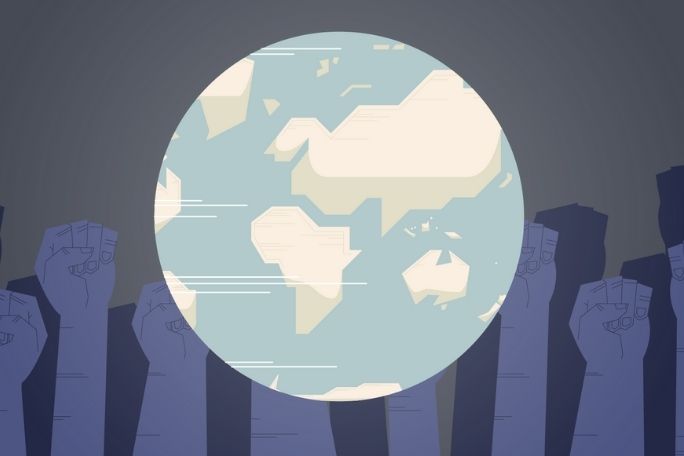Lesson summary
In this Finding Out lesson, students will explore the Universal Declaration of Human Rights (UDHR). They will establish their prior knowledge about the Declaration through the ‘3-2- 1 Bridge’ visible thinking routine, then pose the questions that they have about Australia’s connection with the UDHR. Students will work in groups to conduct quick research around their questions, then share what they find with a partner. Students will work either individually or in groups to create a timeline detailing the development and influence of the UDHR, and use the evidence they gather to support their response to the critical question: “Is the UDHR relevant today?” Students will then reflect on their learning by completing the second part of the ‘3-2-1 Bridge’ visible thinking routine.
Essential questions:
- What is the Universal Declaration of Human Rights (UDHR)?
- How was Australia involved with the development of the UDHR?
- Is the Universal Declaration of Human Rights still relevant today?
Lesson guides and printables
Curriculum links
Select your curriculum from the options below.
Lesson details
Curriculum mapping
(V9) Australian curriculum content descriptions:
Year 10 History:
- The origins and significance of the Universal Declaration of Human Rights, including Australia’s involvement in the development of the declaration (AC9HH10K15)
- Develop and modify a range of historical questions about the past to inform historical inquiry (AC9HH10S01)
- Create descriptions, explanations and historical arguments, using historical knowledge, concepts and terms that incorporate and acknowledge evidence from sources (AC9HH10S08)
- Develop and modify a range of historical questions about the past to inform historical inquiry (AC9HH10S01)
Syllabus outcomes: HT5-2, HT5-8, HT5-10
General capabilities: Literacy, Critical and Creative Thinking, Ethical Understanding.
Relevant parts of Year 10 achievement standards: Students develop and modify a range of questions about the past to inform historical inquiry. They locate, select and compare a range of primary and secondary sources and synthesise the information in sources to use as evidence in historical inquiry. They analyse the origin, content, context and purpose of primary and secondary sources. Students evaluate the accuracy, usefulness and reliability of sources as evidence. They sequence events and developments to analyse cause and effect, and patterns of continuity and change, connected to a period, event or movement. They evaluate perspectives of significant events and developments, and explain the important factors that influence these perspectives. They compare and evaluate different and contested historical interpretations. Students use historical knowledge, concepts and terms to develop descriptions, explanations and historical arguments that synthesise evidence from sources.
Unit of work: Story of Our Rights and Freedoms – Year 10.
Time required: 120+ mins.
Level of teacher scaffolding: Medium- provide some guiding information to students and supervise group activities.
Resources required
- Student Worksheet – one copy per student
- Device capable of audio/visual presentation to present a video to the class
- Student web-enabled devices
- Sticky-notes
- Ultimate Cheatsheet for Critical Thinking (download from here)
- Printed How to Make a Timeline factsheet (from dohistory.org)
Skills
This lesson is designed to build students’ competencies in the following skills:
- Collaboration
- Empathy
- Communication
- Creativity
- Digital literacy
- Ethical understanding
Additional info
Throughout the Story of Our Rights and Freedoms lessons, students will consider Civics and Citizenship concepts through a human rights lens. They will critically assess the Australian system of government and the effect that it has on our rights and freedoms.
There is no universally accepted definition of human rights, and our understanding is continually developing. Some definitions include:
- The recognition and respect of peoples’ dignity
- A set of moral and legal guidelines that promote and protect the recognition of our values, our identity and access to an adequate standard of living
- The basic standards by which we can identify and measure inequality and fairness
- Those rights associated with the Universal Declaration of Human Rights (UDHR)
When we talk about human rights we usually refer to principles that have been agreed upon by countries throughout the world. These rights have been set down in international agreements and form part of international law. They can also be written into the domestic law of individual countries. Human rights cover virtually every area of human life and activity. These include:
- Civil and political rights, such as freedom of speech and freedom from torture
- Economic and social rights, such as the rights to health and education
- Individual rights, including the right to a fair trial
- Collective rights, or those rights that apply to groups of people, such as the right to a healthy environment or to live on one’s ancestral land.
The UDHR is an international document that recognises the basic rights and fundamental freedoms to which all human beings are entitled. It was adopted by the United Nations General Assembly on 10 December 1948 and marks a key milestone in the history of human rights. The Magna Carta, though limited in who it protected, was an important precursor to the UDHR.
Click here to watch a video about the Magna Carta.
You can view the entire text of the Universal Declaration of Human Rights, and the other core international human rights treaties, on the United Nation’s website or by downloading RightsApp (free from the iTunes App store).


Welcome back!
Don't have an account yet?
Log in with:
Create your free Cool.org account.
Many of our resources are free, with an option to upgrade to Cool+ for premium content.
Already have an account?
Sign up with:
By signing up you accept Cool.org's Terms and Conditions(Opens in new tab) and Privacy Policy(Opens in new tab).